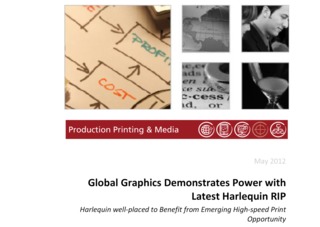Global Graphics Demonstrates Power with Latest Harlequin RIP
The high-speed (inkjet) printing market is expected to grow phenomenally in terms of speed, width, and productivity, which will put tremendous requirements on the RIP. Global Graphics has demonstrated it can play in this market.
Global Graphics, a long standing raster image processer (RIP) developer, has just launched its Harlequin Host Renderer 3 (HHR3). This product is a highly-configurable RIP that digital hardware equipment manufacturers can use in their digital front-ends (DFEs) to drive their print equipment.
To demonstrate the power of the HHR3, Global Graphics asked RIT to do a speed test and commissioned InfoTrends to write an analysis on its technology and the findings of the speed test. The results show that a typical configuration of the Harlequin RIP can easily drive most printers at a speed that is well in excess of the rated speed of the device. When needed, the architecture is also scalable enough to get more performance by adding additional RIPs.
Key Findings
- The high-speed (inkjet) printing market is expected to grow phenomenally in terms of speed, width, and productivity, which will put tremendous requirements on the RIP in terms of data throughput and processing power. Global Graphics has demonstrated it can play in this market with highly efficient, scalable, and robust technology.
- The Harlequin product is based on an architecture that allows for efficient, parallel rendering using multiple CPUs. Global Graphics has also developed technology that automatically detects and optimizes variable data jobs, which increases performance and removes the need for proprietary VDP languages.
- With the PDF-playing field leveled because of PDF being an open standard now, Global Graphics is well positioned to drive high-end PDF ripping and benefit from the AFP/IPDS to PDF migration.
Recommendations
- OEMs developing high-speed, high-volume printing equipment should consider adding Global Graphics to their evaluation list when sourcing RIP technology.
- OEMs that develop mid-range or office type equipment will also benefit from Harlequin technology. While the scope of this white paper is on the high-end (as optimization plays a bigger role there), the product comes with flexible and cost-effective licensing that make it a good fit for those markets, as well.

